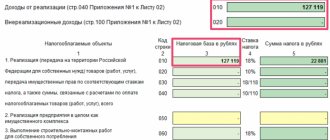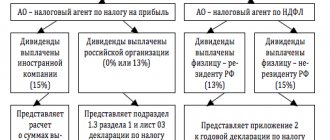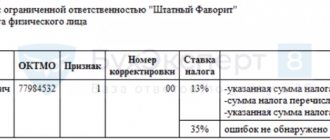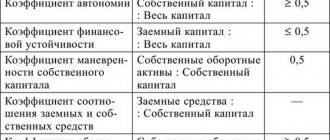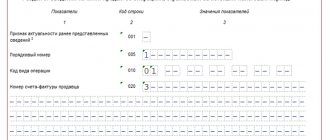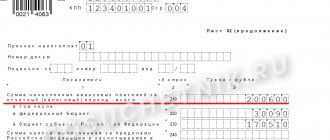Control ratios in the VAT return
The declaration form was introduced by Order of the Federal Tax Service dated October 29, 2014 No. ММВ-7-3/ [email protected]
The Federal Tax Service draws the attention of payers in a letter dated March 23, 2015 No. GD-4-3/ [email protected] (latest version of the letter dated February 13, 2020):
- on control ratios (CR) of document indicators;
- on the possibility of violating specific provisions of the Tax Code in case of non-compliance with the Constitutional Code;
- for further actions of the inspector.
The lack of correlation between indicators is not always a consequence of a serious offense. It is quite possible that the payer himself made basic arithmetic errors that can be corrected thanks to the CC.
What to follow
In 2021, the form, electronic format and procedure for filling out the VAT return are still approved by order of the Federal Tax Service of Russia dated October 29, 2014 No. ММВ-7-3/558. From the 4th quarter of 2021, changes were made by order of the Federal Tax Service dated August 19, 2020 No. ED-7-3/591.
This means that the control ratios in the VAT return given in the letter of the Federal Tax Service of Russia dated March 23, 2015 No. GD-4-3/4550 remain relevant in 2021. Please note that at the beginning of 2021, the latest edition of these ratios is dated 02/13/2020 No. SD-4-3/4921.
Control ratios for VAT: deductions
Let's consider the main CS that require verification in several steps.
Step 1. Control of section 8 - information from the purchase book for the past quarter
Section 8 is completed for each counterparty-seller. In this case, VAT for deduction is recorded in line 180, and the final amount for deduction for the entire purchase book is indicated in line 190, which is filled out on the last page of the section; on the remaining sheets a dash is placed in this field.
As a result, in section 8 the sum of all lines 180 is equal to line 190.
If there is data from additional pages of the purchase book, the equalities are checked:
Actions of the Federal Tax Service
If the inspector sees that the control ratios in the VAT return are not met, as a rule, 2 situations and 2 outcome options are possible.
| № | SITUATION | CONSEQUENCES UNDER THE LAW |
| 1 | A desk audit revealed:
| The Federal Tax Service Inspectorate will send a message with a requirement to provide the necessary explanations within 5 days or make appropriate corrections within the prescribed period (Clause 3 of Article 88 of the Tax Code of the Russian Federation) |
| 2 | A violation of tax laws has been established | The Federal Tax Service will draw up an inspection report (Article 100 of the Tax Code of the Russian Federation) |
Provided that line 050 of section 1 is completed, the Federal Tax Service may send a request for the submission of documents confirming in accordance with Art. 172 of the Tax Code of the Russian Federation, the legality of applying tax deductions, the corresponding amount of which is declared for reimbursement from the budget.
risunok1.png
Step 2. Check Section 3 - Tax Data for Taxable Transactions
The performance of some operations is worth checking again, for example:
- deduction for advances (p. 170 section 3) ≤ final VAT on sales for the quarter (amount p. 010-040 column 5 section 3);
- deduction for construction and installation work for own needs (p. 140 section 3) ≤ amount of VAT charges for such work (p. 060 column 5 section 3).
Step 3. Checking the final amount of deductions
We control the following equalities:
- checking the total amount of deductions under section 3:
New control ratios for value added tax declaration indicators
In connection with the amendments made by Federal Law No. 134-FZ of June 28, 2013 to clause 5.1 of Article 174 of the Tax Code of the Russian Federation, starting from the first quarter of 2015, information given in the purchase book and sales book must be included in the VAT return , and when performing intermediary and some other operations - information from the log of received and issued invoices. The updated form of the tax return also entailed new control ratios of its indicators (Letter of the Federal Tax Service of the Russian Federation dated March 23, 2015 No. GD-4-3 / [email protected] ).
Innovations regarding the calculation of VAT, as well as the procedure for filling out a new declaration, were discussed in a separate article. Now let’s consider the question: what will tax inspectors check in the updated tax return for
VAT.
UPDATED VAT RETURN (PART 1)
UPDATED VAT DECLARATION (PART 2)
The tax return form itself, as well as the Procedure for filling it out (hereinafter referred to as the Procedure for filling out the declaration) were approved by Order of the Federal Tax Service of the Russian Federation dated October 29, 2014 No. ММВ-7-3/ [email protected]
In March 2015, the tax service published Letter of the Federal Tax Service of the Russian Federation dated March 23, 2015 No. GD-4-3 / [email protected] “Control ratios of indicators of tax return forms for value added tax.” The updated ratios involve arithmetic and logical control of the relevant tax return indicators.
Let's analyze the relationship between the main indicators in the table:
| No. | Verifiable reference ratio | The essence of the indicators being verified | Actions of the tax authorities |
| Section 2 (Amount of tax payable to the budget, according to the tax agent) | |||
| 1 | If codes 1011711 and 1011703 are reflected in section 2 of Article 070, then the following inequality must be satisfied: R. 3 tbsp. 180 gr. 3 declaration for the reporting period <= r. 2 tbsp. 060 of the previous tax period in case of acceptance of goods (work, services) for accounting. FOR REFERENCE: Code 1011711 - sale of goods (work, services) to foreign persons who are not registered as taxpayers (clause 1 of Article 161 of the Tax Code of the Russian Federation); Code 1011703 - lease of state property, as well as sale (transfer) of state property (clause 3 of Article 161 of the Tax Code of the Russian Federation). | We are talking about the transaction codes given in Appendix No. 1 to the Procedure for filling out the declaration. Section IV “Operations carried out by tax agents” of Appendix No. 1 of the Procedure contains codes (group 1011700) relating to operations related to the performance of the functions of a tax agent. Payment of VAT is a prerequisite for VAT to be deducted by tax agents. VAT amounts withheld by tax agents are accepted for deduction only after they are actually paid to the budget, i.e. next quarter. The above ratio is intended to control the prevention of unreasonable use of VAT deductions. That is, it is impossible to deduct VAT on goods (work, services) purchased as tax agents in the current declaration in an amount exceeding the VAT amounts previously accrued and paid to the budget. | In case of inequality of indicators leading to an overestimation of the amount of the tax deduction, the tax authorities send a request to the taxpayer to provide the necessary explanations within 5 days or to submit an updated tax return (clause 3 of Article 88 of the Tax Code of the Russian Federation). Otherwise, if facts of violation of the law are established, within 10 days after the end of the desk audit, the tax authorities draw up an act in the prescribed form (Article 100 of the Tax Code of the Russian Federation). |
| 2 | If only codes 1011705 and 1011707 are reflected in section 2 of Article 070, then the equality must be satisfied: R. 3 tbsp. 180 gr. 3 declaration for the reporting period = 0. And therefore, if R.3, Art. 180, Gr.3 > 0, then the deduction is unjustified. FOR REFERENCE: Code 1011705 - sale of confiscated property, property sold by court decision, ownerless valuables, treasures and purchased valuables (clause 4 of Article 161 of the Tax Code of the Russian Federation); Code 1011707 - sale of goods (transfer of property rights, works, services) by foreign persons who are not registered with the tax authorities as taxpayers, on the basis of agency agreements, commission agreements or agency agreements (clause 5 of Article 161 of the Tax Code of the Russian Federation). | In this situation, tax deductions cannot be applied from the amount paid by tax agents under codes 1011705 and 1011707. Thus, intermediaries, having paid VAT to the budget for a foreign person who is not registered with the tax authorities as a taxpayer, do not have the right to claim a tax deduction (clause 3 of Article 171 of the Tax Code of the Russian Federation). The tax deduction will be from the buyer, not from the intermediary. A similar situation arises when selling confiscated property. In the same way, having paid VAT to the budget, you cannot deduct the VAT amount. The basis is clause 3, clause 4 of Article 171 of the Tax Code of the Russian Federation. | Same steps as in step 1 |
| Section 3 (Calculation of the amount of VAT payable to the budget on transactions taxed at the tax rates provided for in paragraphs 2-4 of Article 164 of the Tax Code of the Russian Federation) | |||
| 3 | The following ratio must be satisfied: R. 3 tbsp. (080 - 090 - 100) gr. 5 >= Appendix No. 1 to the river. 3 amounts art. 080 gr. 4 under codes 1011801, 1011802, 1011803, 1011805 for the reporting year specified under Art. 080 gr. 1. FOR REFERENCE: Codes 1011801, 1011802, 1011803, 1011805 - transactions on real estate. | In fact, the difference shown under Section 3 of the declaration must be greater than or equal to the amount of VAT subject to restoration in relation to real estate. On line 090, the amounts of restored VAT are filled in in case the buyer transfers payment amounts, partial payment on account of upcoming deliveries of goods (performance of work, provision of services), transfer of property rights (clause 3, clause 3, article 170 of the Tax Code of the Russian Federation), and on line 100 — restored amounts of VAT when carrying out export operations. And line 080 is the final line, including (among other things) the sum of lines 090 and 100. Failure to comply with this ratio is considered by the tax authorities as an underestimation of the amount of VAT subject to recovery and payment to the budget. | The same steps as in step 1. |
| 4 | The equality must be satisfied: R. 3 tbsp. (010 + 020 + 030 + 040 + 050 + 060 + 070 + 080 + 105 + 106 + 107 + 108 + 109) gr. 5 = r. 3 tbsp. 110 gr. 5. | The above link represents an arithmetic control of indicators, since line 110 of Section 3 reflects the total amount of tax calculated taking into account the restored VAT amounts. Failure to comply with this ratio is considered by the tax authorities as an underestimation of the total amount of VAT payable to the budget. | The same steps as in step 1. |
| 5 | The equality must be satisfied: R. 3 tbsp. 190 gr. 3 = r. 3 tbsp. (120 + 130 + 140 + 150 + 160 + 170 + 180) gr. 3. | The above link represents an arithmetic control of indicators, since line 190 of section 3 reflects the total amount of tax to be deducted. Failure to comply with this ratio is considered by tax authorities as the application of unjustified tax deductions. | The same steps as in step 1. Additionally, tax authorities will require documents confirming the legality of applying tax deductions (Article 172 of the Tax Code of the Russian Federation). |
| 6 | The following ratio must be satisfied: R. 3 tbsp. 170 gr. 3 <= r. 3 tbsp. (010 + 020 + 030 + 040) gr. 5. | The above link concerns the so-called spent advances. Failure to comply with this ratio is considered by the tax authorities as an understatement of the VAT tax base, because the amounts of spent advances are included in sales. Let us illustrate the implementation of the above relationship with an example. EXAMPLE. The organization received an advance payment in the amount of 118,000 rubles in December 2014 and recorded VAT payable in the amount of 18,000 rubles. In the declaration for the 4th quarter of 2014, this amount is reflected in line 070 of section 3. In January 2015, against the received advance payment, goods were shipped in the amount of 118,000 rubles (line 010, gr. 3, section 3). In the declaration for the first quarter of 2015, the spent prepayment will be reflected on line 170, gr. 3, section 3. Let us assume that the taxpayer had no other transactions related to the calculation and payment of VAT in the first quarter of 2015. Thus, the taxpayer will have the following ratio: R. 3 tbsp. 170 gr. 3 (VAT - 18,000 rub.) = r. 3 tbsp. 010 gr. 5 (VAT - 18,000 rubles). | The same steps as in step 1. Additionally, provided that line 050 of Section 1 (VAT amount to be refunded) is filled out, the tax authorities will request documents confirming the legality of applying tax deductions (Article 172 of the Tax Code of the Russian Federation). |
| 7 | The following ratio must be satisfied: R. 3 tbsp. 060 gr. 5 > = r. 3 tbsp. 140 gr. 3. | Carrying out construction and installation works for one’s own consumption is subject to VAT taxation (clause 3, clause 1, article 146 of the Tax Code of the Russian Federation). The tax base for these operations is determined on the last day of each tax period (clause 10 of article 167 of the Tax Code of the Russian Federation) and is reflected on line 060, gr. 5 of section 3. The taxpayer has the right to deduct the accrued amount of VAT on the cost of construction and installation work (paragraph 2 p 5 Article 172 of the Tax Code of the Russian Federation). In this case, the deduction when performing construction and installation works is reflected in line 140, gr. 3, section 3. In the general case, VAT on construction and installation works is zero and the budget receives nothing. And only if one of the conditions is not met (for example, the use of a constructed facility in an “imputed” activity), the VAT previously accepted for deduction is restored. Failure to comply with this ratio is considered by the tax authorities as an unjustified application of tax deductions when performing construction and installation works for their own consumption. | The same steps as in paragraph 6. |
| 8 | The following ratio must be satisfied: gr. 2 adj. No. 2 to the river 3 <= r. 3 pages 110 gr. 5. | Appendix No. 2 to Section 3 is filled out by a taxpayer who is a branch of a foreign organization registered with the tax authorities as a taxpayer, authorized by this foreign organization to submit a declaration and pay tax in general for the operations of all branches of this foreign organization located on the territory of the Russian Federation. Therefore, R.3 p.110, gr.5 includes the amount of VAT calculated on transactions carried out by a branch of a foreign organization, taking into account the recovered amounts and reflected in gr.2 of the appendix. No. 2 to the river 3. Failure to comply with this ratio is considered by the tax authorities as an understatement of the VAT amount due to incomplete reflection of the tax base. | The same steps as in step 1. |
| 9 | The following ratio must be satisfied: gr. 3 adj. No. 2 to the river 3 <= r. 3 pages 190 gr. 3 | Let us note that R.3 p.190 gr.3 includes VAT deductions for transactions carried out by a branch of a foreign organization and reflected in gr.3 appendix. No. 2 to the river 3. Failure to comply with this ratio is considered by the tax authorities as an overstatement of the amount of VAT subject to deduction. | The same steps as in paragraph 6. |
| Section 8 “Information from the purchase book on transactions reflected for the expired tax period” | |||
| 10 | The equality must be satisfied: Art. 160 rub. 3 = [amount according to art. 180 on those sheets r. 8, in which Art. 010 rub. 8 = 19] + [amount according to art. 180 according to those sheets of appendix 1 to the river. 8, in which Art. 010 = 19]. | The above link is a check of the completeness of accounting for transactions related to deductions of the amount of tax paid when importing goods into the territory of the Russian Federation, from the territory of member states of the Customs Union (CU). Code 19 was additionally introduced by the joint Letter of the Federal Tax Service and the Ministry of Finance of the Russian Federation No. GD-4-3 / [email protected] and is used for the import of goods into the territory of the Russian Federation, from the territory of the states of the Eurasian Economic Union. Failure to comply with this ratio is considered by the tax authorities as an overstatement of the amount of VAT subject to deduction in connection with the import of a vehicle into the customs territory. | The same steps as in paragraph 6. |
| 11 | The equality must be satisfied: Art. 180 rub. 3 = [amount according to art. 180 on those sheets r. 8, in which Art. 010 rub. 8 = 06] + [amount according to art. 180 according to those sheets of appendix 1 to the river. 8, in which Art. 010 = 06]. | The above link is a check of the completeness of accounting for transactions related to deductions of the amount of tax paid by the buyer - the tax agent. Code 06 is used for transactions performed by tax agents (Article 161 of the Tax Code of the Russian Federation). Failure to comply with this ratio is considered by the tax authorities as an overstatement of the amount of VAT subject to deduction from the tax agent. | |
| 12 | The equality must be satisfied: page 005 adj. 1 to r. 8 + amount of art. 180 adj. 1 to r. 8 = st. 190 on the last page adj. 1 to r. 8. | In essence, the above link is an arithmetic control of the total values of additional sheets of the purchase book with the total of Art. 190 on the last page of the appendix. 1 to r. 8. Failure to comply with this ratio is considered by the tax authorities as a possible overstatement of the amount of VAT subject to deduction. | The same steps as in paragraph 6. |
| Section 9 “Information from the sales book on transactions reflected for the expired tax period” | |||
| 13 | The equality must be satisfied: amount art. 170 rub. 9 = st. 230 rub. 9 on the last page; amount art. 180 rub. 9 = st. 240 rub. 9 on the last page; amount art. 190 rub. 9 = st. 250 rub. 9 on the last page. | The above link represents a reconciliation of the total value of sales according to the sales book at the appropriate VAT rates (18%, 10%, 0%). | The same steps as in paragraph 6. |
| 14 | The equality must be satisfied: Art. 050 adj. 1 to r. 9 + amount of art. 280 adj. 1 to r. 9 = st. 340 adj. 1 to r. 9; Art. 060 adj. 1 to r. 9 + amount of Art. 290 adj. 1 to r. 9 = st. 350 adj. 1 to r. 9. | The above link represents a reconciliation of the total value of the cost of additional sheets according to the sales book at the corresponding rates (18%, 10%, 0%). Failure to comply with this ratio is considered by the tax authorities as an underestimation of the amount of VAT calculated for payment to the budget. | The same steps as in paragraph 6. |
| Section 12 “Information from invoices issued by persons specified in clause 5 of Article 173 of the Tax Code of the Russian Federation” | |||
| 15 | The equality must be satisfied: Art. 070 rub. 12 = st. 080 rub. 12 - Art. 060 rub. 12. | Section 12 is completed when issuing invoices with allocated VAT (clause 51 of the Procedure): — persons exempt from the duties of VAT taxpayers; — taxpayers when shipping goods, works or services not subject to VAT; — persons who are not VAT payers. Wherein: The amount of VAT presented to the buyer = Cost of goods (work, services), property rights with VAT - Cost of goods (work, services), property rights without VAT. | The same steps as in paragraph 6. |
At the end of the analysis of control ratios, we note that at the time of writing, changes are being prepared to the Order of the Federal Tax Service of the Russian Federation dated February 14, 2012 No. ММВ-7-3 / [email protected] “On approval of codes for types of VAT transactions required for maintaining an accounting journal invoices received and issued." Before the amendments are adopted in the prescribed manner, the Federal Tax Service of Russia recommends using additional codes for the types of VAT transactions given in the Appendix to the Letter of the Federal Tax Service of the Russian Federation dated January 22, 2015 No. GD-4-3/ [email protected]
Thus, when drawing up or receiving an adjustment invoice in connection with a decrease in the cost of shipped goods (work, services), transferred property rights, including in the case of a decrease in prices (tariffs) and (or) a decrease in the quantity (volume) of goods shipped of goods (works, services), transferred property rights, the transaction type code must be entered in the purchase book and sales book - 18.
Control ratios for VAT: calculated tax and amount payable
And again we highlight several stages of verification.
Stage 1. Checking section 9 – sales book data
At this stage, it is worth working with section 9 of the declaration and appendix 1 to it, which are compiled on the basis of the sales book and its additional lists:
| According to the lines of section 9: | ||
| 260 on the last page of the section | Ravna | sum of all lines is 200 |
| 265 on the last page of the section | sum of all lines 205 | |
| 270 on the last page of the section | sum of all lines 210 | |
| According to the lines of Appendix 1 to Section 9: | ||
| 340 | Ravna | Sum of lines 050, 280 |
| 345 | Sum of lines 055, 285 | |
| 350 | Sum of lines 060, 290 | |
| Equality between a section and its appendix: | ||
| Appendix line 1 to section 9 | Ravna | Section line 9 |
| 050 | 260 | |
| 055 | 265 | |
| 060 | 270 | |
| 070 | 280 | |
If the rules are not met, it means that the tax payable is underestimated.
Stage 2. Checking section 3 – calculation of VAT payable
The interconnection of the indicators in Section 3 deserves attention:
How to Apply Ratios
Unlike other forms of reporting, the VAT return can be called self-sufficient. Therefore, all control relationships for it are of an intra-documentary nature. That is, the accountant needs to compare and contrast the indicators only indicated within this tax reporting form.
The control ratios for the VAT return have a tabular form and a traditional structure. It includes:
- serial number of the ratio;
- possible violation of the legislation of the Russian Federation (Tax Code of the Russian Federation) due to inconsistency of indicators;
- formulation of the violation according to the Tax Code of the Russian Federation;
- how the inspector will act if a non-compliance with the control ratios is detected.
